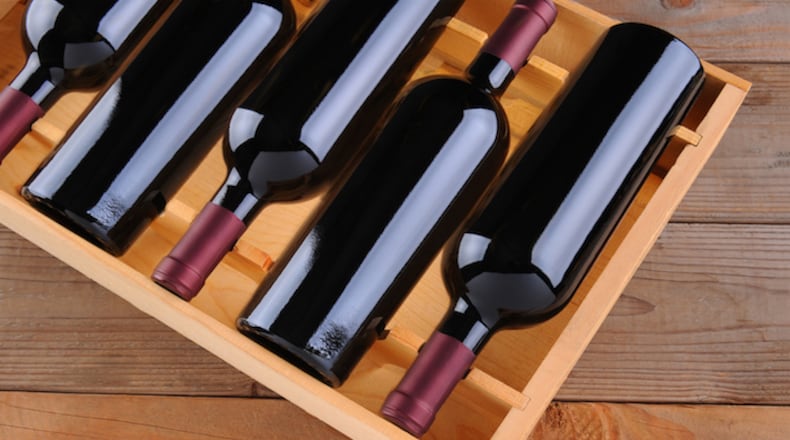My high school classmates got together for a reunion this year — let’s not get into numbers, shall we? — and the passage of time brought forth nothing but beauty on that idyllic autumn weekend.
Between an informal party Friday night and the official reunion Saturday night, I rendezvoused with a few classmates for a three-hour lunch of homemade pizza and bottle-aged wine. Pristine chunks of wood went into our friend’s brick oven, and out came sizzling, bubbling-crust pizzas, which floated to us on a thin paddle at the end of a long handle.
To honor the occasion, I had pulled a few old bottles from my collection. What better time to drink aged wine than at a reunion lunch with old friends? None of the wines was terribly fancy, or crassly expensive. They were just very good wines in the $35 to $50 range that had been resting comfortably for somewhere close to a decade.
Do you want to know a secret? Most wines would be lame if you let them sit for that long. You’ve heard that a fine wine improves with age? It’s true, but the key word there is “fine,” and wine that is worthy of that label is very rare, indeed — somewhere between 1 and 2 percent of all wine made.
Wines that can age for 15 or 20 years are rarer still, and wines that can last longer than that and still be good might as well be categorized as both “fine” and “legendary.” These are the wines that set themselves apart — like Elvis, Cher and the Artist Known as Prince When I Was in High School.
Alas, most of us cannot afford the Elvises of wine. Even the Elvis impersonators of wine are often out of the budget. It’s fine, though, because in the space between the bottle of “Elvis” and the bottle of the “pop-star-of-the-moment-whom-no-one-will-remember-come-Arbor-Day,” there are lots of solid, semi-affordable wines that will age nicely for 10 years, give or take.
What those wines will offer after that long maturation period are deeper aromas and flavors, and a softer, more peaceful expression than they would have been capable of when they were bottled. A lot of wines that can be aged for decades are fighters when they are young — full of overpowering fruit and acid, and tannin that could rival steel wool.
A newly bottled wine is like a high school kid on graduation day. Not every high school graduate is the same, and, like a newly bottled wine, one kid might be at or near his peak, while another may need some time to find her way and become what she is destined to be. Thankfully, human development and wine maturation run counter to each other. While only 1 or 2 percent of wine gets better as the years roll on, a much higher percentage of high school graduates go on to achieve the greatest successes of their lives over the next 40 or 50 years: their careers, their families, their wisdom and contentment.
With some years behind them, ageable wines develop aromas and flavors that arrive in a wave of profound, earthy seduction. They are more intriguing now. Their fresh, youthful fruit has transformed into something more complex and layered. They are less prone to confrontation, and more comfortable in their own skin. Like an old leather chair, they offer the distinct look of history, of time passed: Red wines get lighter with age (from purple to brick), and white wines get darker (from hay to honey).
Here’s my advice. You didn’t ask for it, but come on, I’ve just been through a high school reunion — I’m full of perspective. Buy some good wine — California cabernet sauvignon, Bordeaux, Barolo, German riesling, vintage port — anything with high tannin, acid or sugar, and consider it a splurge because generally the more you spend, the better the wine will age. No wine that costs $25 or less is meant to be aged more than a couple of years if it’s red or a year if it’s white.
Think of this as an investment in luxury and the gentle gifts of time. Buy a few bottles of the same wine. Lay them down in a cool, dark, humid place, and drink one five years from now. Drink another one two years after that, and then another one two or three years after that. Make that investment every year, and you’ll always have special, aged bottles on hand.
I remember clearly where I bought the wines that I opened with my friends, and it was fun to daydream for a second or two during lunch about where I was in life when I was wrapping those bottles in T-shirts and stuffing them into my suitcase. Thinking back even further, I pictured the four of us on graduation day, squinting into the sun as church bells rang out and our brown robes flapped in the wind. My goodness, there was so much ahead of us.
For a truly rewarding experience, invite some old friends to drink your aged wine with you. It will surely give you some perspective of your own. And if you really want to align yourself with the passage of time and nature’s powerful rhythm, when Arbor Day rolls around next year, plant a tree.
About the Author
The Latest
Featured


